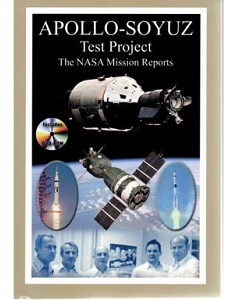This excellent long-running series of NASA Mission Reports continues with a volume that ties up Apollo coverage with a mission that utilised a spare Apollo spacecraft for an historic political meeting in orbit at the height of the Cold War. The Apollo-Soyuz Test Project (ASTP), which took place in 1975, was a surprise to many at the time, but presaged the cooperative spirit embodied by the International Space Station today.
In common with other books in the series, this one comprises facsimiles of original NASA documents including the ASTP press kit, mission evaluation report and crew debrief. It is illustrated with the original line diagrams and a few monochrome photos.
As is often the case with these compilations, it is the crew debriefing interviews at the back that contain the most interesting information. Thus we read a discussion on blowing the hatch after splashdown: Stafford says, “You remember Gus Grissom, during Mercury 4”; Slayton comments, “I wasn’t at all eager about getting that hatch opened too quick”; and Brand concludes, “When we finally did open it, we did it the right way… I was concerned [we’d break] a swimmer’s leg or something if we opened it up too fast”. Stafford adds that he “did that one time on Gemini 9” and “bang, it went flying through the air”.
As usual, the factor that makes this series unique is the ‘exclusive bonus DVD’ bound inside the back cover, which includes film material from suit-up to splashdown, the handshake, inflight press conference, Soyuz landing and so on. Grouped together with similar volumes on the Apollo and Skylab missions, this volume completes a fantastic resource in any space buff’s personal library.











